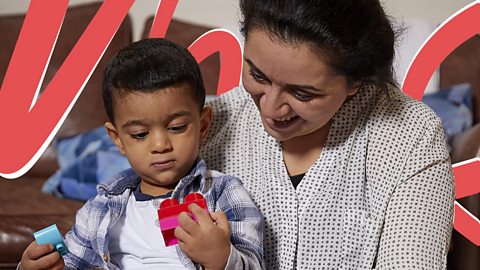The leaves are changing, autumn is here, and itÔÇÖs time to get spooky!
Halloween can be full of new sights and sensations for your little ones and is also a fantastic opportunity to practise vocabulary and encourage learning through play. Why not make a little at-home Halloween party for your child, complete with fun and games?
Specialist speech and language therapist Alys Mathers has conjured up some spooktacular Halloween activities to get you started.

Get gutsy with spooky sensory play
Rather than carving a pumpkin, why not light up your little onesÔÇÖ smiles by getting together to paint one?
You can use fingers or tools to decorate, or even cut pumpkin pieces into shapes for your child to stamp and identify. These donÔÇÖt have to be complicated ÔÇô crescent moons, clouds and stars are still on-brand for a dark and stormy night.
Using colours associated with Halloween such as black, orange, green and purple might also present a good naming challenge for younger children.
Take it further and create a scary texture playground: fill bowls with pumpkin insides, peeled and chopped up grapes and spaghetti worms and let your little ones explore.
ÔÇťGetting children used to feeling different textures and talking about together expands your childÔÇÖs vocabulary,ÔÇŁ says Alys.
Remember that expressing disgust is just as important as expressing delight.
Encourage sounds like ÔÇśooh!ÔÇÖ and ÔÇśyuck!ÔÇÖ so your child can share when they like or dislike a texture.

Models and mummies
Halloween wouldnÔÇÖt be Halloween without fancy dress! Putting a costume together can also be a great way to introduce some new vocabulary.
ÔÇťDressing up is a good opportunity to talk about names of clothing and practice some descriptive words,ÔÇŁ says Alys.
Raid the wardrobe and encourage them to pick out an outfit ÔÇô and donÔÇÖt forget to model language as well as your clothes. Give your child lots of examples of descriptive words in full sentences to show them how the words are used.
For example, you could say: ÔÇťI want the sparkly top,ÔÇŁ or ÔÇťI like this long scarfÔÇŁ. You can even make it seasonal by adding: ÔÇťThis is the same colour as the pumpkin, isnÔÇÖt it?ÔÇŁ
Similarly, you can use toilet paper to get wrapped up in the fun. Alys says making your child into a mummy is a great way to identify body parts:
ÔÇťAsk them to tell you where to wrap them up next, ÔÇśPut it on my legÔÇÖ, ÔÇśarmÔÇÖ, and so on, and theyÔÇÖll be practising the names of body parts at the same time.ÔÇŁ
You can encourage them to take charge by asking: ÔÇťWhere are you going to wrap next?ÔÇŁ or ÔÇťShall we do the other leg now?ÔÇŁ

TreatÔÇŽ or treat
For very young children, giving out treats is a chance to practice saying or indicating they want ÔÇśmoreÔÇÖ ÔÇô an important skill.
Alys suggests making it into a game: give them a little bit of a treat, then when they reach for some more, say, ÔÇťDo you want more, or finished?ÔÇŁ
ÔÇťEncourage them to say they want more, or ask for the thing, before you give it,ÔÇŁ she says. ÔÇťThey need the opportunity and expectation to ask with words ÔÇô or signs ÔÇô in order to use them.ÔÇŁ
For bigger children, putting a twist on trick or treat is something you can do at home.
Hide little ÔÇśtreatsÔÇÖ around the house ÔÇô either sweets, healthy snacks they love or spooky ornaments and toys ÔÇô then give your child instructions for where to find them, such as ÔÇťLook under the kitchen table,ÔÇŁ or ÔÇťOpen the cupboard by the doorÔÇŁ.
This will help them with listening and following instructions in a fun way.
In the dark, dark, hourÔÇŽ
What better way to end a day of Halloween fun than a bedtime ghost story?
When you read to your child, put them in charge of making the sound effects. For example, you could give them a shaker to shake whenever you say the word ÔÇśskeletonÔÇÖ, or ask them to make a ÔÇśwoooÔÇÖ noise whenever you say the word ÔÇśghostÔÇÖ.
ÔÇťYou can give older children a few different noisemakers to make more sound effects,ÔÇŁ says Alys. ÔÇťThis helps develop their listening skills.ÔÇŁ

In case you missed it
Download our interactive weekly schedules
Browse our interactive activity schedules, challenges and checklists. All of our PDFs are interactive, which means that you can click on any activity and find out more.





